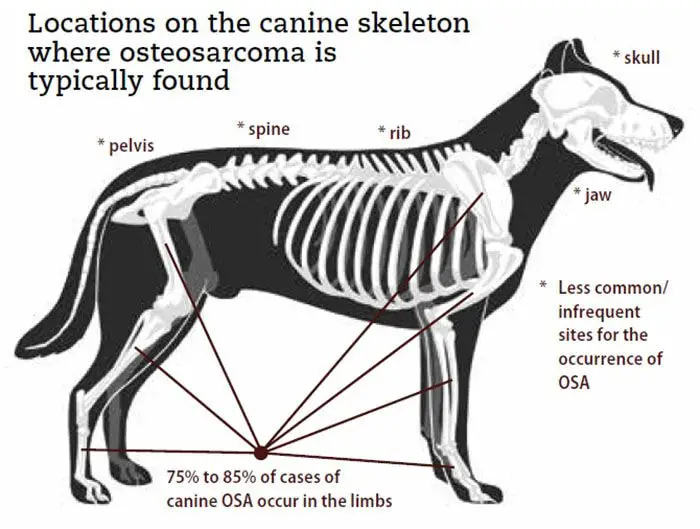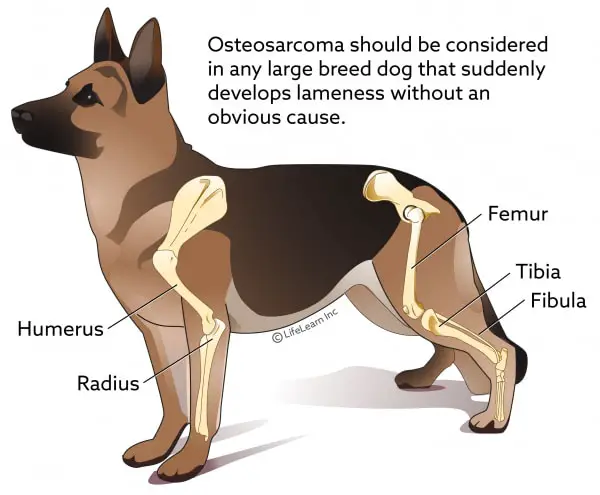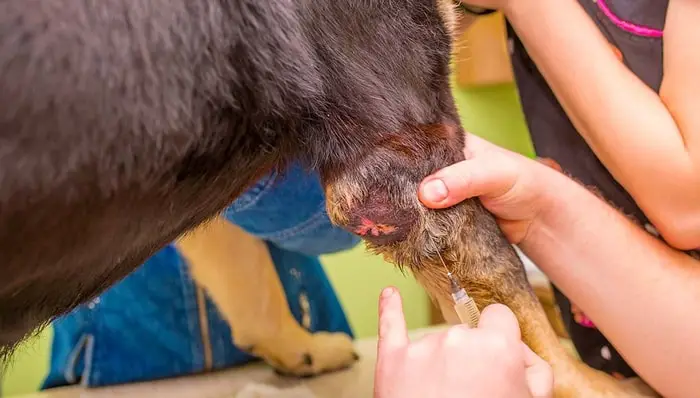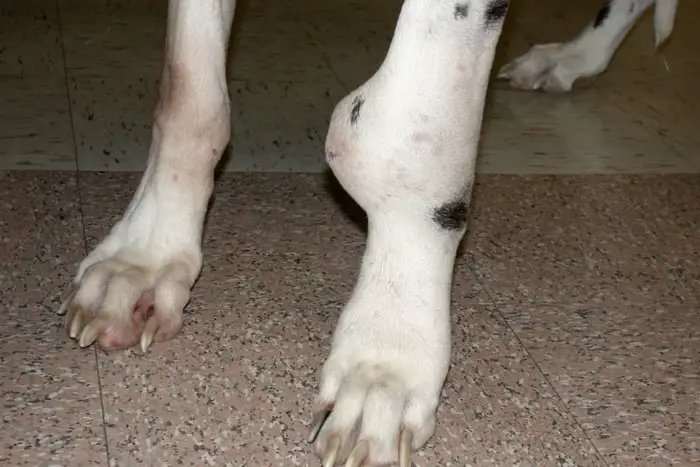Osteosarcoma in dogs is the most common bone cancer in canine families. The disease mainly affects the larger dog breeds and in older age. Cancer mainly occurs in the long bones like the humerus, femur but is also seen in the maxilla, pelvis, skull, vertebrae, and ribs. The tumor is highly aggressive and painful and causes the breakdown of long bones. The cancer is rarely found in the non-bone tissues like mammary glands and muscles.
Important Information on Osteosarcoma in Dogs
Osteosarcoma in dogs is the most common malignant tumor of bone tissues. The disease is similar to pediatric osteosarcoma in children. The disease results from abnormal growth and proliferation of bone cells (osteocytes) due to any external or internal influences. Bone tissues then break into osteoblasts and osteoclasts.
Osteosarcoma mainly affects the long bones of dogs but may also be found in shorter bones like the skull, mandible, maxilla, vertebrae, and ribs. The disease may also spread to soft tissues due to metastasis like kidney, liver, muscle, spleen, and mammary glands. The condition is called extra-skeletal osteosarcoma.
Causes of Bone Cancer in Dogs
The exact causes of tumor or cancer formation in the bone cells of dogs is unknown. There are many internal or external causes are involved in initiating the growth of cancer cells. The formation of cancer cells varies due to environmental factors, breed of dogs, size of the dogs, age of the dogs, and health status. The genetic factors also play a vital role in osteosarcoma in dogs.

Breeds of Dogs Prone to Canine Osteosarcoma
The disease is mainly affected in the larger dog breeds and mostly after middle age to older age. The following breeds of dogs are more vulnerable to osteosarcoma:
- German Shepherd.
- Doberman Pinscher.
- Great Dane.
- Golden Retriever.
- Boxer.
- Iris Terrier.
- The Great Pyrenees.
- Iris Wolfhound.
- Rottweiler.
- Labrador Retriever.
- Iris Setter.
- Weimaraners.
- Saint Bernards.

Pathogenesis of Osteosarcoma in Dogs
The osteosarcoma in dogs is extraordinarily aggressive and spreads very rapidly. When you diagnose the disease initially, it spread almost 90-95% to other organs. You can find micro-osteoblast in other organs. You to analyze the blood and urine to see the extent of the spread of the disease.

Clinical Signs of Bone Cancer
The initial clinical signs of osteosarcoma are a pain in joints and long bones. The pain is unbearable, intermittent, and has occasional lameness. The administration of a pain killer may subside the pain. The other clinical signs are:
- Break down of long bones.
- Enlargement of lymph nodes.
- Dogs unable to walk.
- Lethargic.
- Loss of appetite.
- When spread to vital organs causes fever, coma, and death.

Diagnosis of Osteosarcoma in Dogs
Early diagnosis of the disease and removal of the tumor surgically have a tremendously favorable prognosis. The methods of diagnosis of the disease are:
- History of the breeds, age, and genetic information of dogs.
- Specific clinical signs.
- Radiography (X-ray) examination of the bones ( humerus, femur, and affected area).
- Ultrasonography of internal organs.
- Blood analysis for the presence of osteocytes in the circulatory system.
- Biopsy of bone tissues.
- CT scan of the affected area.

Differential Diagnosis of Canine Osteosarcoma
Osteosarcoma in dogs is a multiple proliferative disease of bone tissues. The disease spread very rapidly to other organs and tissues. The disease manifests many non-specific clinical signs. The disease must be differentiated from the following diseases:
- Chondrosarcoma (tumor of cartilage cells).
- Synovial cell carcinoma (found only in synovial fluid).
- Fungal Bone Tumor caused by Coccidiodes immitis.
- Squamous cell carcinoma is mainly found in periosteum tissues.

Treatment of Osteosarcoma in Dogs
After proper diagnosis, the following treatment strategies can be taken by the veterinarian.
- In primary tumors, surgically remove or amputate the affected limbs to stop the spread to other organs or tissues.
- If the tumor becomes metastatic and spread to other organs of tissues, chemotherapy is the only means of treatment.
- To reduce the pain, you can give pain killers or NSAIDs.
- Palliative Radiotherapy can be given to reduce excessive pain.
Prognosis and Fate of Osteosarcoma in Dogs
The prognosis of osteosarcoma in dogs is not good. The disease spread very rapidly to other organs before diagnosis. The dog should survive with cancer for the rest of its life. The amputation and chemotherapy may relieve pain and suffering. Basing the location and extent of spread, the dog may survive from 2 months to 6 months.